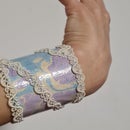Introduction: Cat With Blinky Eyes and Nose // Light and Sound Sensors
About a year ago, I made a cat lamp shade and I thought that it would be nice to make a circuit for the cat's eyes to light when the light goes down.
I finally made time (mentally mostly) to do the circuit.
It makes the eyes of the cat blink every 5 seconds when there is little light and the nose blink five times when there is a sound in the vicinity of the lamp.
I hope you enjoy it. I surely do like to make something just for fun from time to time.
The circuit is made with an Attiny85 as it has to be rather small. To see how to program it using Arduino Uno, check out my first tutorial.
Supplies
- Arduino Uno
- Attiny85
- Jumperwires
- Breadboards
- Sound sensor
- Phototransistor
- 6 x 5V LEDs for the eyes
- 2 x 5V LEDs for the nose
- 3 x 100k resistors
- 1 x 220k resistor
Step 1:
Connect the VCC and GND of the Attiny to the Arduin Uno to provide power.
Step 2:
Connect the LEDs of the eyes and nose to the Attiny
- LeftEye - pin 4
- RightEye - pin 2
- Nose - pin 0
To see the diagram of the Attiny pins go here.
The LEDs can be organized however suits you, just make sure to connect all the ground and out pins, respectively, together.
Step 3:
Connect the phototransitor:
- one pin of the phototransitor to the VCC of the Attiny
- the other pin of the phototransitor to a 220k resistor and to the 3 pin of the Attiny
- the second pin of the resistor to the GND
Step 4:
Connect the sound sensor:
- GND to ground
- VCC to VCC
- OUT to 1 pin of the Attiny
Step 5: Code
int lefteye = 2;
int righteye = 4; int nose = 0; int lightSensorPin = 3; int analogValue = 0; int sensor = 1; int val = 0;] void setup() { pinMode(lefteye, OUTPUT); pinMode(righteye,OUTPUT); pinMode(nose,OUTPUT); pinMode (lightSensorPin, INPUT); pinMode(sensor, INPUT); } void loop(){ digitalWrite(lefteye, LOW); digitalWrite(righteye, LOW); digitalWrite(nose, LOW); sound (); light (); } void light () { analogValue = analogRead(lightSensorPin); if(analogValue < 50){ digitalWrite(lefteye, HIGH); digitalWrite(righteye, HIGH); delay (500); digitalWrite(lefteye, LOW); digitalWrite(righteye, LOW); delay (300); } } void sound () { val =digitalRead(sensor); if(val==0){ for ( int i =0; i<5; i++){ digitalWrite(nose, HIGH); delay (200); digitalWrite(nose, LOW); delay (200); } } }
Step 6: Final Result
To make the circuit to fit the head of the cat, you have to solder it to a prototype board.
I chose for power to solder a 5V AC/DC Adaptor, but you can use a USB port as well or bateries although they are not environmentally ok. ^.^
Enjoy! :)











